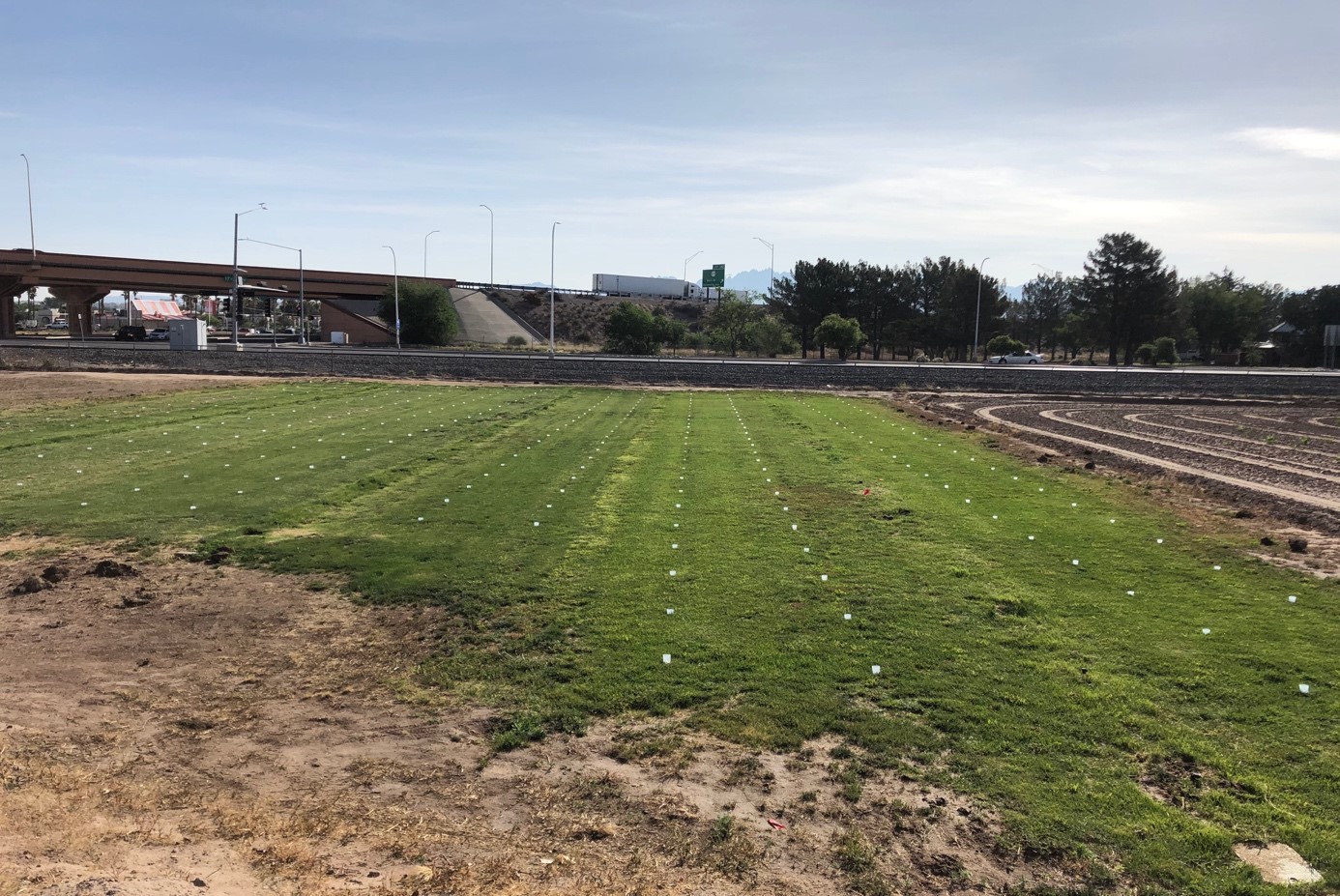NMSU Graduate Student Studying Herbicide Phytotoxicity in Turfgrass Under Drought Conditions
By Catherine Ortega Klett, NM WRRI Senior Program Manager
Water management is one of the most pressing issues turfgrass managers face in the arid regions of the world. In response to reduced water supplies, governments routinely enact policies that restrict the use of potable water for non-essential uses. In New Mexico, regional and local climate change impacts may result in increased evaporation, reduced irrigation flows, and decreased soil moisture available for turfgrass growth.
Ornamental crops like turfgrass provide many environmental benefits like soil erosion reduction, increased oxygen production, ambient temperature reduction, and esthetically pleasing and low-cost ground cover for recreational purposes. Herbicides are the primary management tool used to reduce difficult-to-control weeds in turfgrass stands. Therefore, it is important to investigate how to optimize herbicide applications under drought conditions, given that drought-stressed plants may be more vulnerable to herbicide toxicity, and that the efficacy of herbicides may be reduced under such conditions.
This is the subject of a research project being conducted by Jackson Powers, a master’s degree student in horticulture in the NMSU Department of Plant and Environmental Sciences. In partial support of his research, last year Jackson received an NM WRRI Student Water Research Grant entitled: Herbicide Phytotoxicity Under Drought Conditions in Warm and Cool Season Turfgrass. Jackson has been working in collaboration with his faculty advisor, Dr. Ryan Goss, an associate professor in the same department.
The approach taken in this study has been to perform field and greenhouse experiments under controlled conditions. The still ongoing field experiments are being conducted at the Fabian Garcia Research Science Center (FGRSC) in Las Cruces, NM. A linear gradient irrigation system (LGIS) ‒ in which a single row of sprinkler heads is arranged to provide an irrigation continuum varying linearly from none to excessive water with length along a grass plot ‒ is used to differentially irrigate a plot that is also exposed uniformly to one herbicide treatment. For the field experiment, irrigation is scheduled twice weekly to replace the evapotranspiration (ET) losses that occur within 1.5 meters of the LGIS linear array, by making use of local weather data obtained from a nearby NMSU weather station. Five experimental areas have been established, each with its own independent LGIS.
Grasses investigated include bermudagrass, perennial ryegrass, Kentucky bluegrass, and a mixture of the latter two along with tall fescue. In addition, four weed species have been introduced into each plot after establishment; these include green foxtail, annual bluegrass, dandelion, and white clover, based on the high economic impact these weeds have on turfgrass systems in the Las Cruces area. Also, all plots are maintained at a height of 5 cm, which would be appropriate for golf course rough or a residential lawn. The photo below shows an example of a field plot system.

Calibration of cool season LGIS research plots
After each plot is differentially irrigated for two weeks, it also receives a combination of herbicide applications involving a combination of two rates for a set of 14 herbicides. Plots are visually rated for turfgrass and weed quality and phytotoxicity, as well as percent turfgrass green cover along the irrigation gradient up to 60 days after treatment.
The greenhouse experiment is being conducted at the research greenhouses at FGRSC. Bermudagrass and Kentucky bluegrass are being grown to 5 cm height in 1gallon pots with uniform irrigation. After maturity, plants are exposed to four decreasing water contents (80, 60, 40, 20% ET) for two weeks, and then sprayed with herbicide applications for eight herbicides at two different rates. Pots are visually rated for turfgrass phytotoxicity, quality, and density for up to 60 days after treatment. The first trial of the greenhouse experiment was completed in summer 2018, and the second trial was initiated as of April 2019.
The data and results of the first trial were presented at the NM WRRI annual water conference in October 2018. After completion of the trial, it was concluded that two herbicide label rates (maximum label rate and twice that rate) were needed both in the field and greenhouse experiments to determine adequately the interaction between turfgrass water status and herbicide phytotoxicity and efficacy. The second trial of the greenhouse experiment is underway, and data will be available in July 2019. The field experiments will take place in May-June 2019 and August-September 2019.
The methodology used in this experiment can also be used to evaluate certified organic herbicides’ performance under differing water statuses, which can be important for Las Cruces, given the recent outcry from citizens over the use of conventional herbicides. Determining the minimum water status needed for effective use of each mode-of-action herbicide will benefit turfgrass managers in New Mexico and other regions that experience periodic drought conditions. These results can also be used as a management tool by athletic field managers, golf course superintendents, and other landscape managers to determine whether herbicide applications will be effective and appropriate for preserving turfgrass quality by controlling weeds during drought. Local governments can use this kind of decision-making tool to manage their public turfgrass sites like parks and athletic fields under reduced water conditions, and in a way that minimizes the use of wasteful or damaging herbicides. It may also preclude the need for water use to reestablish turfgrass that would otherwise be damaged due to a poor herbicide application. Ultimately, this research should help ensure that the environmental benefits provided by turfgrass will be preserved under the drought conditions seen in New Mexico.
Jackson is originally from Portales, NM and received an undergraduate degree from NMSU in 2017. His tentative graduation date for an MS degree is in the spring of 2020. After graduation, Jackson hopes to pursue a career in the turfgrass industry, either through research or commercial turfgrass management, so he can help ensure that ornamental crops like turfgrass will still be able to provide their environmental benefits under drought conditions in his native state.
